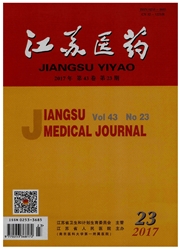

 中文摘要:
中文摘要:
目的分析利妥昔单抗治疗淋巴瘤的远期疗效及中期PET/CT评估的意义。方法收集191例淋巴瘤患者资料;其中,利妥昔单抗治疗108例(A组),非利妥昔单抗治疗83例(B组)。回顾性分析利妥昔单抗治疗淋巴瘤的远期临床效果及其患者预后的影响因素。结果与B组比较,A组完全缓解(CR)率较高(94.4%vs.83.1%)(P〈0.05),复发率较低(6.4%vs.22.9%)(P〈0.01),5年生存率较高(65.7%vs.44.6%)(P〈0.05)。利妥昔单抗诱导治疗CR后且维持其治疗组的5年生存率高于中断其治疗组(85.5%vs.50.0%)(P〈0.05)。侵袭性淋巴瘤患者采用含利妥昔单抗治疗者的5年生存率高于非利妥昔单抗治疗者(61.7%vs.38.6%)(P〈0.05)。行中期PET/CT检查患者的5年生存率高于未行者(66.7%vs.53.7%)(P〈0.05)。HBsAg阳性、年龄〉65岁、β2微球蛋白升高、免疫分型(如弥漫大B细胞淋巴瘤)和有颅内侵犯是预后不良的因素(P〈0.05)。结论利妥昔单抗可提高淋巴瘤患者CR率,减少复发。首选利妥昔单抗达CR后维持其治疗能明显改善预后。实施中期PET/CT检查有利于评估化疗疗效,选择更为合理的化疗方案。
 英文摘要:
英文摘要:
Objective To analyze the long-term efficacy of rituximab and clinical significance of interim evaluation with PET/CT in the patients with different forms of non-Hodgkin lymphoma.Methods A total of 191 patients with non-Hodgkin lymphoma was divided into two groups of A(treated with rituximab,108cases)and B(treated without rituximab,83cases).The long-term efficacy and the factors influencing the prognosis were retrospectively analyzed.Results Compared to group B,group A had a higher complete remission(CR)rate(94.4% vs.83.1%)(P〈0.05),lower relapse rate(6.4%vs.22.9%)(P〈0.01),and higher 5-year overall survival rate(65.7%vs.44.6%)(P〈0.05).The 5-year survival rate was higher in the cases with a maintenance therapy of rituximab after CR than that in those without maintenance therapy of rituximab(85.5%vs.50.0%)(P〈0.05).The 5-year survival rate was higher in the cases with aggressive lymphoma treated with rituximab than that without rituximab(61.7%vs.38.6%)(P〈0.05).The 5-year survival rate was higher in the cases had interim evaluation with PET/CT than that without(66.7%vs.53.7%)(P〈0.05).HBsAg positive,aged 〉65 years old,central nervous system-involved,increase ofβ2-microglobulin and non-Hodgkin lymphoma immunotype DLBCL were the factors for poor prognosis(P〈0.05).Conclusion Rituximab therapy can improve CR and decrease recurrence rate in the patients with non-Hodgkin lymphoma.The prognosis of patients with non-Hodgkin lymphoma can be improved by keeping a maintenance therapy of rituximab after CR.Interim evaluation with PET/CT may be a powerful tool for monitoring the response to therapy,by which a better therapeutic regime is selected.
 同期刊论文项目
同期刊论文项目
 同项目期刊论文
同项目期刊论文
 期刊信息
期刊信息
